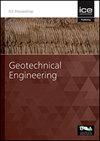The surface bearing capacity of a strong granular layer on weaker sand
IF 1.7
4区 工程技术
Q3 ENGINEERING, GEOLOGICAL
Proceedings of the Institution of Civil Engineers-Geotechnical Engineering
Pub Date : 2023-03-16
DOI:10.1680/jgeen.22.00094
引用次数: 0
Abstract
Stronger granular layers are often placed as working platforms over weaker sand subgrade. The design of a working platform involves the calculation of a two-layer bearing capacity under rectangular loading. Existing design methods are either overly simplified, based on infinitely long strip loads, validated by a small number of small-scale 1g model tests or rely on numerous or empirically derived charts that are difficult to use or implement into design software. In this paper a new and highly practical design method is proposed where bearing capacity is determined simply from the shear strengths and unit weights of the two soil layers. It was derived from extensive FEA and FELA parametric studies in both plane strain and axisymmetric geometries and validated against published physical model tests, other FELA analyses and existing design methods. It can be applied to all rectangular shape ratios with dry and saturated layers.弱砂土上强颗粒层的表面承载能力
较强的颗粒层通常被放置在较弱的砂路基上作为工作平台。某工作平台的设计涉及矩形荷载作用下两层承载能力的计算。现有的设计方法要么过于简化,基于无限长条荷载,通过少量小规模1g模型试验验证,要么依赖于大量或经验推导的图表,这些图表难以使用或在设计软件中实现。本文提出了一种新的、实用的设计方法,即简单地根据两土层的抗剪强度和单位重来确定承载力。该结果来源于广泛的FEA和FELA平面应变和轴对称几何参数研究,并通过已发表的物理模型试验、其他FELA分析和现有设计方法进行验证。它可以应用于所有矩形形状比例与干燥和饱和层。
本文章由计算机程序翻译,如有差异,请以英文原文为准。
求助全文
约1分钟内获得全文
求助全文
来源期刊
CiteScore
4.40
自引率
4.50%
发文量
68
审稿时长
3 months
期刊介绍:
Geotechnical Engineering provides a forum for the publication of high quality, topical and relevant technical papers covering all aspects of geotechnical research, design, construction and performance. The journal aims to be of interest to those civil, structural or geotechnical engineering practitioners wishing to develop a greater understanding of the influence of geotechnics on the built environment.

 求助内容:
求助内容: 应助结果提醒方式:
应助结果提醒方式:


